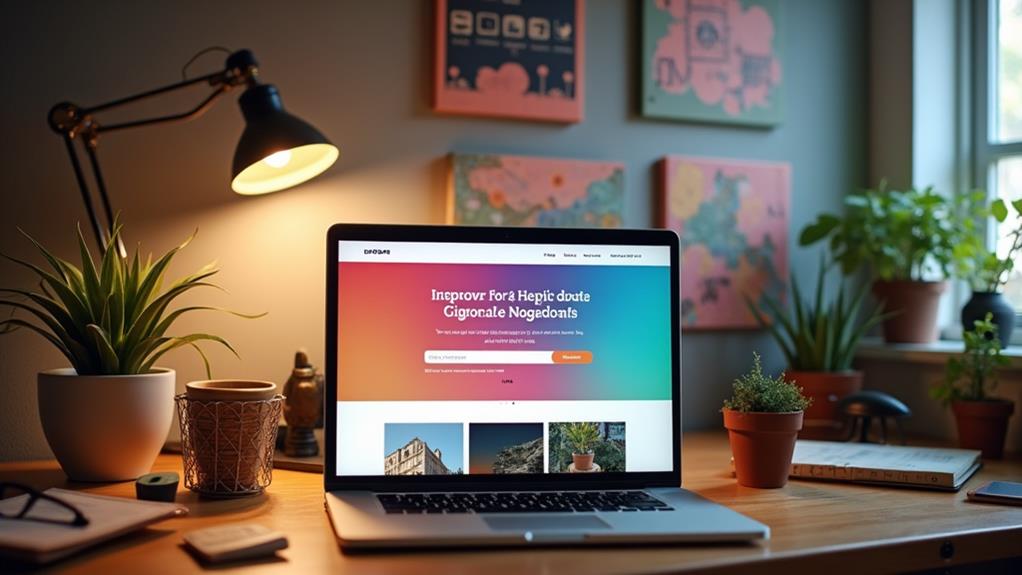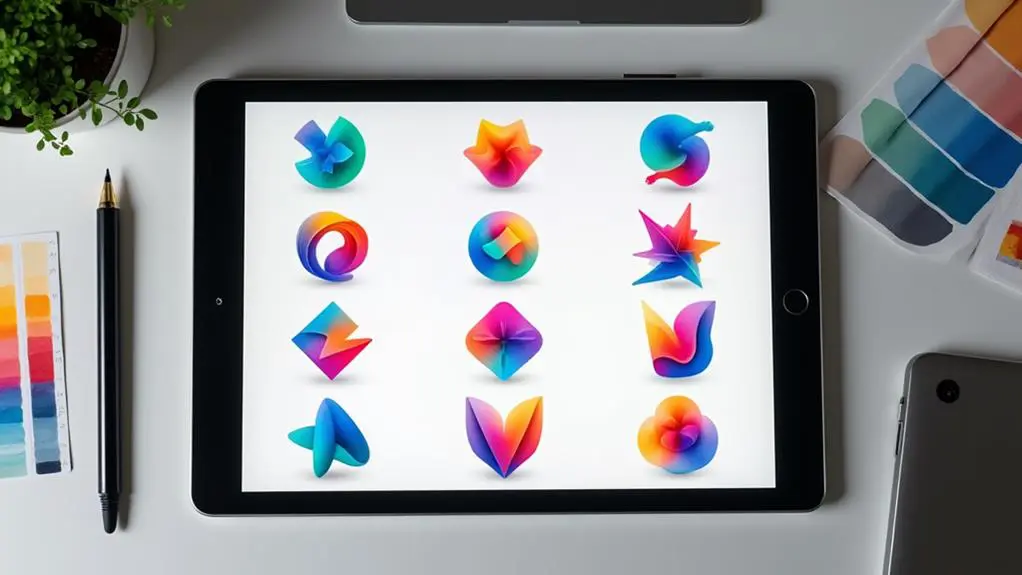Creating a memorable logo for your small business website is a journey into visual storytelling and brand essence. Begin with simplicity; a clean design guarantees instant recognition. Color choice is vital—beneath the surface, it evokes emotions and boosts brand recall. Typography speaks volumes; select fonts that echo your business's voice. Balance and proportion in design elements enhance aesthetic harmony and memorability. Study competitors to unearth trends and gaps, guaranteeing a distinctive mark. Each element, from iconography to color, should be versatile across media, guaranteeing a cohesive identity. To uncover the secret ingredients of enduring logo design, consider what's next.
Key Takeaways
- Focus on simplicity for easy recognition and effective communication of your brand's identity.
- Choose colors that align with brand values and resonate with your target audience.
- Select typography that reflects your brand's personality and enhances readability.
- Ensure the logo is versatile and maintains clarity across different media formats.
- Analyze competitor logos to identify market gaps and create a distinctive design.
Importance of Logo Design
A logo acts as the face of a business, encapsulating its identity in a single, striking image. It serves as a visual representation that not only establishes brand recognition but also fosters trust among consumers. The psychology of logos is vital; a well-designed emblem can evoke specific emotions and associations, reinforcing brand storytelling. This narrative begins with the logo, setting the tone for how a brand is perceived and remembered.
Distinctive logos, like the iconic Nike swoosh, highlight the importance of creativity in design. They need not depict the company's offerings directly; rather, they should resonate with the target audience, encapsulating the brand's personality and values. This resonance enhances recall and loyalty, as consumers are more inclined to remember brands with unique visual identities.
Visual elements such as shape, color, and typography are essential in crafting a logo that aligns with a brand's core values. These elements, when thoughtfully combined, can create powerful emotional connections.
For small businesses, a logo is not merely an aesthetic choice but a strategic tool that communicates the intended message clearly. Fundamentally, effective logo design is integral to successful brand storytelling and consumer engagement.
Understanding Design Principles
Design's fundamental principles serve as the cornerstone for creating an impactful and memorable logo. At the heart of these principles lies simplicity; by embracing clean designs, a logo becomes more recognizable and memorable, allowing it to stand out even from a distance. This simplicity is enhanced through a carefully crafted visual hierarchy, guiding viewers' eyes effortlessly from the most essential elements to the subtler details.
Color choice, a pivotal aspect of design fundamentals, greatly influences brand recognition, potentially boosting it by up to 80%. Colors should harmonize with the brand's personality and values, guaranteeing they evoke the intended emotional response.
Typography additionally enriches the logo's narrative, with fonts conveying distinct emotional tones. Selecting the right typeface guarantees readability and enhances the brand's perception.
Achieving balance in composition is vital for aesthetic appeal. Proportionate relationships between different elements contribute to a cohesive and visually appealing design.
In addition, logos must be versatile across various media. Testing for scalability in different sizes and formats confirms that the logo remains clear and impactful, regardless of where it appears. This adaptability guarantees the logo's effectiveness in diverse contexts, reinforcing its memorability.
Choosing the Right Iconography
Selecting the right iconography is an essential step in creating a logo that resonates with your audience and encapsulates your brand's essence. Icon symbolism plays a significant role in making your logo instantly recognizable, serving as a visual shorthand for your brand's identity. By choosing symbols that authentically represent your business, you create a link between your company and its core values.
Abstract representation, such as Nike's swoosh, can evoke emotions and forge strong associations, enhancing your brand's narrative.
When designing your icon, consider the balance between simplicity and visual impact. A simple design aids memorability and guarantees that your logo is easily identifiable across various platforms. The icon's visual weight should align with the text elements, maintaining a harmonious relationship that enhances the logo's overall aesthetic.
Ideally, the icon's height should match or exceed that of the text, achieving a balanced and cohesive look.
Furthermore, keeping the proportionate relationship between icon and text guarantees coherence and aesthetic appeal. This visual symmetry not only strengthens your brand's image but also aids in creating a lasting impression.
Effective Typography Choices
In the domain of logo design, typography serves as a powerful tool to articulate your brand's personality and ethos. Selecting the right typeface is vital for reinforcing your brand image; serif fonts convey tradition and reliability, while sans-serif fonts suggest modernity and approachability. Effective font pairing is essential, with the recommendation to limit your design to a maximum of two fonts—one for the brand name and another for the tagline. This approach maintains visual coherence and guarantees the typography hierarchy is clear and compelling.
Consider the impact of letter casing as well; uppercase letters can impart a sense of strength and authority, whereas lowercase letters often cultivate a friendly and casual feel. This subtle choice influences customer perception markedly. Additionally, confirm legibility across sizes, particularly for smaller applications like business cards or website headers. Consistent typography across all branding materials further strengthens brand identity and fosters cohesive recognition.
| Typeface | Personality | Application |
|---|---|---|
| Serif | Traditional | Reliability |
| Sans-serif | Modern | Approachability |
| Uppercase | Strong | Authority |
| Lowercase | Casual | Friendliness |
Analyzing Competitor Logos
To craft a logo that stands out, begin by meticulously examining the visual elements that define competitor logos in your industry.
By identifying prevalent color schemes and typography trends, you can uncover opportunities to introduce unique elements that highlight your brand's identity.
This strategic differentiation not only fills market gaps but also guarantees your logo captures attention while avoiding the pitfalls of visual similarity.
Identifying Market Gaps
The vibrant palette of competitor logos serves as a rich canvas for identifying market gaps and crafting a memorable logo for your own brand. By conducting a thorough analysis of at least 5-10 competitor logos, you can uncover common design trends and messaging styles that largely characterize your industry. Focus on the visual representation and how these logos align with consumer expectations. This examination allows you to pinpoint elements that resonate with your audience and identify opportunities for differentiation.
| Element | Competitor Insights | Market Gap Exploration |
|---|---|---|
| Colors | Predominantly blue shades | Explore warmer tones |
| Typography | Bold, sans-serif fonts | Consider serif or script |
| Imagery | Abstract symbols | Introduce literal imagery |
| Messaging Style | Formal and corporate | Opt for friendly, casual |
| Design Trend | Minimalist | Explore intricate designs |
Evaluating strengths and weaknesses through a SWOT analysis reveals strategic insights. For instance, if competitors lean heavily on minimalist designs, exploring more intricate or illustrative styles could fill a market gap. Similarly, if competitor messaging is overly formal, a more approachable tone might better meet consumer needs. By addressing these overlooked aspects, you can create a logo that not only fulfills unmet expectations but also stands out in a crowded marketplace.
Color and Typography Trends
Building on the insights gained from identifying market gaps, a closer inspection of color and typography trends in competitor logos reveals a fascinating interplay of design elements that shape brand perception. Analyzing these logos can disclose color palettes that resonate with target audiences, drawing on color psychology to evoke specific emotions and associations.
For example, blues often convey trust and professionalism, while greens suggest growth and sustainability. Identifying industry-specific colors can guide your selections, ensuring they align with consumer expectations while standing out in a crowded marketplace.
Typography, too, plays a critical role in crafting a memorable logo. As seen in competitor logos, font pairings can enhance readability and reflect brand personality. Sans serif fonts, known for their modernity and simplicity, are frequently employed to convey a clean, contemporary image.
Observing common typeface trends can inform your own design choices, ensuring your logo remains relevant yet distinctive.
Moreover, competitor analysis can highlight effective use of whitespace and layout, offering insights into achieving design balance. By understanding these elements, small businesses can create logos that are both visually appealing and professionally polished, ensuring a strong, lasting impression.
Differentiation Through Unique Elements
Amidst a sea of logos vying for attention, a strategic approach to differentiation can propel your brand into a spotlight of its own. By meticulously analyzing competitor logos, you can uncover prevalent design elements and themes within your industry. This analysis reveals opportunities for crafting a distinctive visual identity that resonates with brand storytelling.
Pay close attention to the color palettes, typography, and iconography used by competitors. Identifying gaps in these areas allows you to select unique combinations that will make your brand stand out.
In your quest for differentiation, evaluate the simplicity and memorability of competitors' logos. Aim for a design that is not only distinctive but also easily recognizable, guaranteeing your brand's enhanced visibility in the marketplace.
Implementing a SWOT analysis will further guide you in understanding how your logo can effectively communicate your business values while capitalizing on competitors' weaknesses.
Additionally, keeping an eye on industry trends by observing how competitor logos evolve over time can provide valuable insights. This can guide your logo's design to secure its longevity and relevance, ultimately creating a visual identity that is both timeless and compelling in its brand storytelling.
Ensuring Brand Consistency
Across the vast digital landscape, ensuring brand consistency is paramount for crafting a memorable identity. At the heart of this endeavor lies adherence to brand guidelines, a roadmap that defines your visual identity. This involves selecting a cohesive color palette and typography that resonates across platforms, from your website to social media and marketing materials.
Consistency in logo usage fortifies brand recognition and instills trust among your audience. Implementing a Brand Kit is a strategic move to standardize logo application and color schemes, ensuring a unified brand image. This kit serves as a visual compass, guiding the application of your logo in various contexts—be it on business cards, promotional items, or digital interfaces.
Such uniformity not only enhances brand recall by up to 80% but also reinforces customer associations, making your brand instantly recognizable. Regularly engaging with your logo across diverse mediums bolsters familiarity. Each interaction, whether subtle or bold, compounds your brand's identity in the minds of consumers.
Frequently Asked Questions
How Do I Make a Memorable Company Logo?
To craft a memorable company logo, prioritize design principles that emphasize simplicity and originality. Leverage color psychology to evoke emotions aligned with your brand. Guarantee versatility across formats, incorporating unique visual elements that encapsulate your brand's essence.
How Do I Make a Logo for My Small Business?
Start by defining your brand identity to guide the logo design process. Utilize user-friendly tools like Canva for customization. Prioritize simplicity and color psychology, enhancing visual impact. Gather feedback from potential customers to refine your design.
How Do I Create a Creative Logo for My Business?
To create a creative logo for your business, integrate innovative logo design with a cohesive branding strategy. Prioritize visual elements that emphasize originality and align with your brand's narrative, ensuring the design communicates effectively and captivates your audience.
What Makes a Catchy Logo?
A catchy logo effectively combines color psychology and strategic font selection with visual simplicity and unique shapes, ensuring brand alignment. This fosters audience connection by creating a distinctive, memorable impression that embodies the brand's identity and resonates with consumers.
Conclusion
Crafting a memorable logo for a small business website requires a strategic blend of visual elements and design principles. A well-designed logo embodies the brand's essence, ensuring its iconography and typography resonate with the target audience. By meticulously analyzing competitor logos and maintaining brand consistency, a distinctive identity is forged. This synthesis of creativity and analytical thought results in a logo that not only captivates visually but also stands as a symbol of the brand's values and aspirations.




